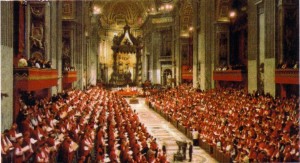 [1]The announcement that the Church will beatify Pope Paul VI in October has led some observers to declare that Rome is intent on “canonizing” the Second Vatican Council by raising the Popes responsible for that assembly to the honor of the altars. Pope John XXIII who convened the Council was made a saint last month along with John Paul II who was present at the Council and supported its implementation; while the pontiff now set to be beatified in October presided over the Council’s conclusion and shaped its reform program.
[1]The announcement that the Church will beatify Pope Paul VI in October has led some observers to declare that Rome is intent on “canonizing” the Second Vatican Council by raising the Popes responsible for that assembly to the honor of the altars. Pope John XXIII who convened the Council was made a saint last month along with John Paul II who was present at the Council and supported its implementation; while the pontiff now set to be beatified in October presided over the Council’s conclusion and shaped its reform program.
This is a tempting interpretation of the recent activity of the Congregation for the Causes of Saints–the Church agency charged with recognizing new saints–but likely to be off base.
In the first place, it is axiomatic that the Church canonizes saints, not pontificates or governance programs. As the veteran Italian Vatican correspondent Andrea Tornielli observed after the canonization of John XXIII and John Paul II, “Whoever was expecting [the] event to be an exaltation of the historic role held by the two Popes who were raised to the altars this morning, will have been disappointed.”
Extolling the virtues of the new saints, Pope Francis praised the Christian focus of their lives, and not their “attempts to reaffirm identities, mythical visions of Popes ending wars or breaking down walls and that sense of an increasingly self-referential nostalgia felt by those who have put faith in a cage,” wrote Tornielli.
The Church is not canonizing recent popes because they have implemented better reform programs, but because they have arguably led holier lives devoted to prayer and spirituality. This has more to do with the First Vatican Council, opened in 1869, than the Second Vatican Council, which reshaped our generation’s experience of the Faith.
The conclusion that the trend of making popes into saints has to do with Vatican II fails to account for the fact that the first modern pope to be canonized is St. Pius X, who predated Vatican II by sixty years. Pius XII, who also predates Vatican II, has been declared Venerable. And Pius IX, the Pope who presided over the First Vatican Council, has been declared a Blessed. What is really going on with these saintly popes?
To understand the question, it helps to look at the earliest years of the papacy. For the first 300 years of church history, every single pope was sainted; and 52 of the first 54 pontiffs are venerated this way. Accordingly, making popes saints was the norm–at the beginning.
After the first millennium, that changed for various reasons. In the early years, there were many persecutions and the earliest popes were martyrs. After the Middle Ages, the papacy became a bastion of earthly power and there was a lot of corruption.
But of the last ten popes who have died, seven are in some stage of canonization. Three of these popes are already saints, two have been recognized as venerable, and one other has been beatified, which seems much closer to the early norm in the Church.
It is no coincidence that the streak changes with Bl. Pius IX, the pope who opened the First Vatican Council. This Council recognized the dogma of papal infallibility. The Council was closed down when Italy overran the Papal States, relegating subsequent popes to being “prisoners of the Vatican” and, more importantly, stripped of earthly power and confined to being Supreme Pontiffs over spiritual and moral concerns only.
In my view, that is the principal reason we are seeing so many modern papal saints. History and Vatican I have pushed the Holy Fathers to be holy fathers once again.